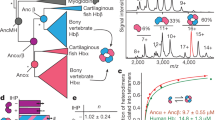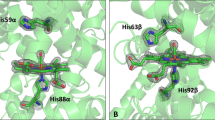Abstract
PROTEINS in the globin family are found in a variety of species from bacteria to man1, 3. From the many globin sequences known, evolutionary trees have been constructed showing that α and β globins diverged from a common ancestor between 425 and 500 million years ago, after vertebrate species had appeared and roughly when sharks and bony vertebrates diverged4–6. The αand β globins assemble to form tetrameric haemoglobin,α2/ β2, which can switch between quaternary states having high and low oxygen affinity7. This allows the protein to bind oxygen cooperatively and therefore efficiently transport oxygen from the lungs to respiring tissues. The αand β globins have closely related tertiary structures, being α-helical proteins with similar haem-binding sites. Most globins consist of eight helices, designated A to H from the N terminus, connected by short nonhelical segments, but all known vertebrate α globins lack a D helix. Because the loss of this helix by α globin occurred shortly before tetrameric haemoglobin appeared, it might be a functionally important mutation required for a tetramer assembly or allostery. We have now tested this idea by engineering human haemoglobins containing β subunits without a D helix and α subunits with a D helix. Both of these mutations have little effect on the oxygen-binding properties of the molecule. Thus it is possible that deletion of the D helix in the α subunit was caused by a neutral mutation8.
This is a preview of subscription content, access via your institution
Access options
Subscribe to this journal
Receive 51 print issues and online access
$199.00 per year
only $3.90 per issue
Buy this article
- Purchase on Springer Link
- Instant access to full article PDF
Prices may be subject to local taxes which are calculated during checkout
Similar content being viewed by others
References
Braunitzer, G., Gehring-Müller, R., Hilschmann, N. & Hilse, K. Hoppe-Seyler's Z physiol. Chem. 325, 283–286 (1961).
Dayhoff, M. O. Atlas of Protein Sequence and Structure Vol. 5 and Suppl. 1–3 (National Biomedical Research Foundation, Washington DC, 1972).
Kleinschmidt, T. & Sgouros, J. Hoppe-Seyler's Z. biol. Chem. 368, 579–615 (1987).
Perutz, M. F. Molec. Biol. Evol. 1, 1–144 (1983).
Dickerson, R. E. & Geis, I. Hemoglobin: Structure, Evolution and Pathology (Benjamin Cummings, Menlo Park, California, 1983).
Lesk, A. M. & Chothia, C. J. molec. Biol. 136, 225–270 (1980).
Fermi, G. & Perutz, M. F. Atlas of Molecular Structure in Biology 2: Hemoglobin & Myoglobin (Clarendon Press, Oxford, 1981).
Kimura, M. Sci. Am. 241, 94–104 (1979).
Arutyunyan, E. G., Kuranova, I. P., Vainstein, B. K. & Steigemann, W. Soviet Phys. Crystallogr. 25, 43–52 (1980).
Huber, R., Epp, O., Steigemann, W. & Formanek, H. Eur. J. Biochem. 19, 42–50 (1971).
Love, W. A. & Karle, J. J. molec. Biol. 74, 331–361 (1973).
Padlan, E. & Love, W. E. J. biol. Chem. 249, 4067–4078 (1974).
Royer, W. E., Hendrickson, W. A. & Chiancone, E. J. biol. Chem. 264, 21052–21061 (1989).
Kendrew, J. C. et al. Nature 185, 422–427 (1960).
Dodson, G., Hubbard, R. E., Oldfield, T.j., Smerdon, S. J. & Willkinson, A. J. Protein Engng. 2, 233–237 (1988).
Wakabayashi, S., Matsubara, H. & Webster, D. A. Nature 322, 481–483 (1986).
Hoffman, S. J. et al. Proc. natn. Acad. Sci. U.S.A. 87, 8521–8525 (1990).
Aschauer, H., Weber, R. E. & Braunitzer, G. Hoppe-Seyler's Z. biol. Chem. 366, 589–599 (1985).
International Hemoglobin Information Center Hemoglobin 9, 229–298 (1985).
Perutz, M. F. Mechanisms of Cooperativity and Allosteric Regulations in Proteins (Cambridge University Press, 1990).
Nagai, K., Perutz, M. F. & Poyart, C. Proc. natn. Acad. Sci. U.S.A. 82, 7252–7255 (1985).
Imai, K. Meth. Enzym. 76, 438–449 (1981).
Author information
Authors and Affiliations
Rights and permissions
About this article
Cite this article
Komiyama, N., Shih, DB., Looker, D. et al. Was the loss of the D helix in α globin a functionally neutral mutation?. Nature 352, 349–351 (1991). https://doi.org/10.1038/352349a0
Received:
Accepted:
Issue Date:
DOI: https://doi.org/10.1038/352349a0
This article is cited by
-
Biophysical reviews ‘meet the editor series’–Jeremy R. H. Tame
Biophysical Reviews (2021)
-
Transplanting a unique allosteric effect from crocodile into human haemoglobin
Nature (1995)
-
Protein engineering in haemoglobin
Nature (1992)
Comments
By submitting a comment you agree to abide by our Terms and Community Guidelines. If you find something abusive or that does not comply with our terms or guidelines please flag it as inappropriate.



